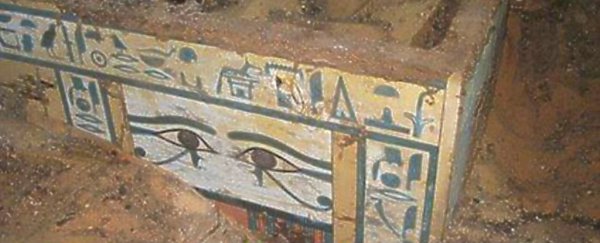The daughter of a prince and the mother of two of the most powerful governors in the Middle Kingdom of Egypt, a noblewoman known as Lady Sattjeni has been unearthed some 3,800 years after her death, in an ancient tomb in southeastern Egypt.
Wrapped in linen and deposited inside a wooden coffin inside another wooden coffin, Sattjeni's remains are still remarkably preserved, and were found alongside an inscription identifying her as the woman whose family sat directly below pharaoh Amenemhat III, who ruled ancient Egypt from 1800 to 1775 BC.
"The discovery is of a historic importance because Sattjeni is one of the most important figures in the Middle Kingdom, being the mother of Heqaib III and Amaeny-Senb - two of the highest authorities of Elephantine under the reign of Amenemhat III," Mahmoud Afify, head of the Ancient Egyptian Archaeology Sector at Egypt's Ministry of Antiquities, announced today.
This Russian Doll-style double-coffin provided such incredible protection from the elements, remains of Sattjeni's facepaint and original burial mask were still intact, made from layers of linen and papyrus, and covered in plaster.
The inner coffin was so well preserved, archaeologists could not only figure out the type of wood used to construct it - cedar from Lebanon - but also the year that it was cut. Let's just stop for a second to take that in: scientists now have the capability to figure out the date - down to the year - that a single tree was felled to construct a coffin almost 4,000 years ago.
The tomb was found inside the royal necropolis of Qubbet el-Hawa, a group of rock-cut tombs on the western bank of the Nile, opposite the south Egypt city of Aswan.
While many of the tombs inside have been dated to the Old Kingdom of ancient Egypt - during the 3rd millennium BC - some, like Sattjeni's, come from a more recent time when the royal family of southern Egypt was located on the famous island of Elephantine, which floats in the middle of the Nile.
Here, Sattjeni, the daughter of daughter of Prince Sarnbhut II, gave birth to two sons, Heqaib III and Ameny-Seneb, who would become the most powerful governors during the rule of Amenemhat III.
The team of Spanish archaeologists behind the discovery will now analyse her remains to figure out what she looked like, when she died, and what the most likely cause of death was.
"The body of Sattjeni was laying in her original position with some remains of the original covering of wrappings. The body is in excellent condition, which will permit our team of anthropologists to know more about her living conditions, age of death, pathologies, ethnic features," the Ministry of Antiquities told the press.
The team is yet to publish their findings, but we should see an official report once the autopsy has been completed.
